
Forged in the fires of Jacques Lemaire’s defense-first philosophy, the Minnesota Wild spent nearly two decades with a well-earned reputation for stingy defense. They also had an even better-earned reputation for being boring. Since Kirill Kaprizov arrived in 2020, they’ve bucked that trend to a degree, ranking 9th in goals per game in 2020-21 and 5th in 2021-22.
It was something special when the Wild combined that defensive reputation with superstar scoring in 2021-22. Kaprizov, Kevin Fiala, and Mats Zuccarello poured offense over their opponents, ranking 16th in goals allowed per game. They finished in the top five in the NHL with 113 standings points.
In the following seasons, the pillars of Minnesota’s defensive identity have eroded. Alex Goligoski and Jon Merrill were key role players on that ’21-22 roster, but now they spend most of their time in the press box. Matt Dumba left in the 2023 offseason and took his physical presence with him. Going back further, the Wild bought Ryan Suter out in 2021. While he isn’t the most popular name in town, Suter’s buyout was for the good of the team’s culture and salary cap more than his on-ice performance.
Zach Bogosian, Declan Chisholm, and Brock Faber became Minnesota’s defensive replacements. Chisholm is fun to watch and executes his role well, but he’s mostly a role player. While he put on a good showing in his first full-time action, he’s already 24. It’s rare for a player to join the NHL that late and grow into a top-four defenseman.
Bogosian was also serviceable in his minutes this season. However, his 2023-24 performance was his best of the past three years, and he turns 34 in July.
That typically indicates regression is coming, and his play between 2021-23 barely met the threshold of an NHL roster. This type of long shot usually becomes a lightning rod for fan criticism. Examples from ‘23-24 include Goligoski, Merrill, and Marcus Johansson.
That leaves a lot of slack for Faber to pick up. But even if he grows into a player who can make up for what the Wild have lost in its role players, that’s not enough. Minnesota’s other top-four defensemen appear to be regression candidates.
Each of Brodin, Middleton, and Spurgeon has a story that makes them seem eternal. Spurgeon is the unstoppable underdog. He’s probably the best active NHL defenseman to play at or below 5’9” and one of the top 20 defensemen in the league, regardless of height. Jake Middleton is the throwback. His parents raised him blue-collar, and he used to work as a bricklayer in the offseason. Maybe that’s why he’s built like a brick outhouse. Then there’s the smooth-skating Swedish wunderkind Jonas Brodin.
Minnesota’s top three feel like an institution, but it’s nearly reached its shelf life. Next season, Brodin will be 31, Middleton 29, and Spurgeon turns 35 in November. That may not sound very old, but these guys will almost certainly regress. Based on research from HockeyViz.com, defensemen’s offensive, defensive, and shorthanded peak comes at age 22, 25, and 27, respectively.
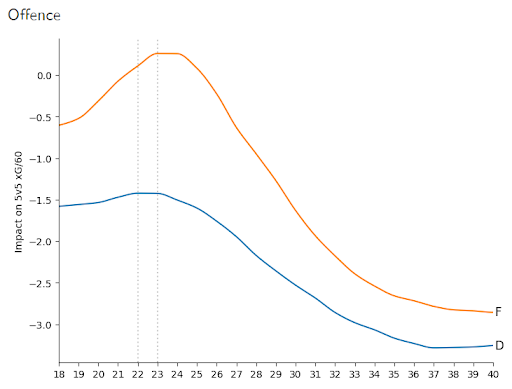
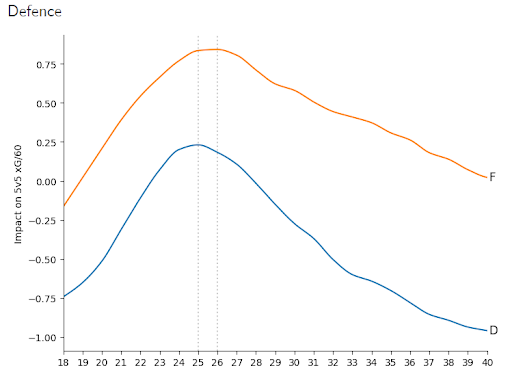
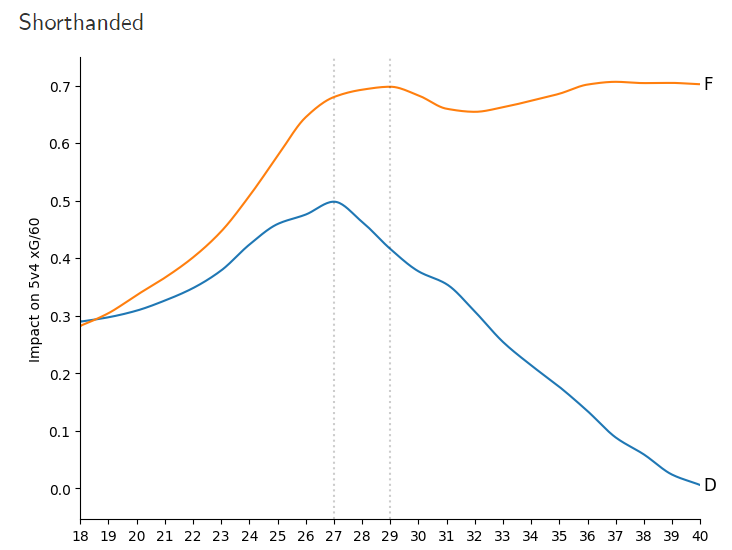
There’s little hope that these three players will age gracefully. Each has already had injury problems.
Brodin suffered two injuries last season. He had an upper-body injury, which kept him out for about a month, and an apparent leg injury where his knee twisted up beneath him. Speculatively, this is concerning over the long term due to the potential for ligament damage, which could impact his skating.
Spurgeon started last season with a shoulder injury he sustained in a preseason game. Then, far more concerning was hip and back surgery. As exceptional as Spurgeon was playing before the procedure, major surgery for any athlete at this age is a concern now and in the future.
It’s tough to guess how recurrent Middleton’s upper-body injury from late last season might be, but The Athletic reported that he had “a knee injury that was cleaned up after the season.” Knee problems often have lingering effects after treatment, and they flare back up more often than the average injury. Furthermore, his physical brand of hockey doesn’t bode well for avoiding the nicks and bruises that come with his lunch-pail style of play.
Injuries are a double-edged sword. Not only is it harder to return from injuries at a later age, but there’s some indication across sports that injuries are the primary cause of age-related decline.
Running back a late-stage defense corps wouldn’t be an issue if the Wild were in the throes of a Stanley Cup window. However, they’re coming off an 87-point season with a roster consistently lost in the first round.
Even with the additions of a second-line winger and better health, the Wild aren’t a Stanley Cup contender in 2024-25. By the time this roster has a chance to compete, this top-four won’t be the Infinity Stones anymore. They’ll be Brock Faber and some old guys.
The chances of reinforcements arriving by that time aren’t great either. Minnesota has only drafted two defensemen in the first round in the past decade: Carson Lambos in 2021 and Filip Johansson in 2018. Even more shockingly, they’ve only drafted three other defensemen in rounds two or three: Ryan O’Rourke (2nd round, 2020), Louie Belpedio (3rd round, 2014), and Daemon Hunt (3rd round, 2020). None of these players project to become top-pairing defensemen, leaving a gaping hole on Faber’s left long-term.
All this puts a real damper on the exciting forward group poised to break out in the next two to three seasons. Even if the front office bats 1.000 by re-signing Kaprizov, adding a second-line forward this offseason, bringing over Danila Yurov, and developing Marat Khusnutdinov and Liam Ohgren, somebody has to defend the net front. Jesper Wallstedt also would have to become an elite goalie.
Don't believe me? Let’s examine the playoff teams that a cornerstone defenseman carries. The best-case scenario is the New York Rangers with Adam Fox. After Fox, their six best players are five forwards and goaltender Igor Shesterkin, one of the five best goaltenders in the NHL.
There isn’t another perfect analogy, although the Boston Bruins and Vancouver Canucks are close. They have three or four elite forwards, and each had a goaltender play incredibly well through the regular season in Linus Ullmark and Thatcher Demko, respectively.
Each of these playoff contenders has a match fighting for their lives in the basement. Jake Sanderson of the Ottawa Senators, Vince Dunn of the Seattle Kraken, Zack Werenski of the Columbus Blue Jackets, and Noah Dobson of the New York Islanders posted great all-around numbers in The Athletic’s player analysis model. However, none had any real shot at a Stanley Cup by the time April rolled around.
At this point, it seems impossible for the Wild to reclaim that boring defensive identity. Why would they? The 2020s have brought fans probably the best hockey in franchise history. However, without that identity, Minnesota doesn’t just need to nail a series of front-office moves.
They need to reinvent their identity.
Think you could write a story like this? Hockey Wilderness wants you to develop your voice, find an audience, and we'll pay you to do it. Just fill out this form.
-
 2
2



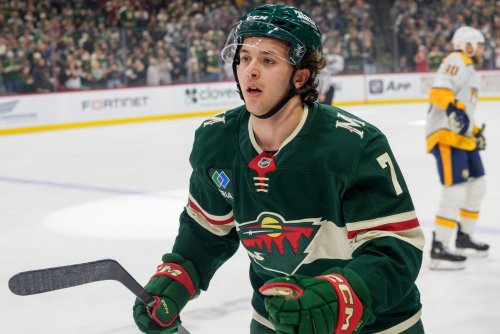
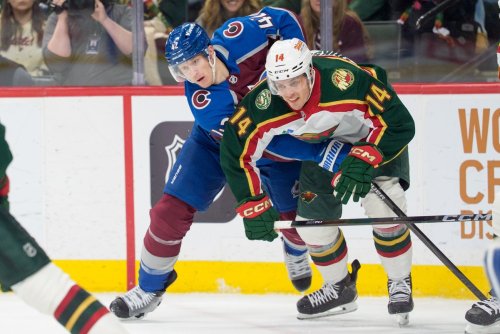


Recommended Comments
Join the conversation
You can post now and register later. If you have an account, sign in now to post with your account.
Note: Your post will require moderator approval before it will be visible.